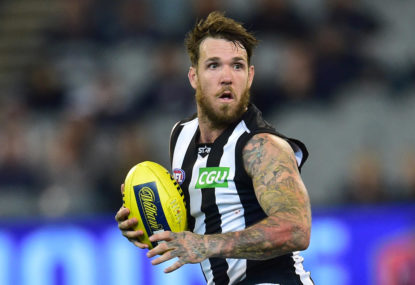LISTEN: Darcy Moore skilfully dodges question about whether the AFL should bring in extra time
Diplomatically answered, Darcy!

The Collingwood Football Club has had its fair share of legends. Dane Swan ranks among the best of them.
Swan is one of Collingwood’s ten greatest players of all time, and while that may surprise some, it shouldn’t.
The Coventry brothers – Syd and Gordon – are locks in Collingwood’s top ten, ditto Peter Daicos, Phil Carman, Bob Rose and Albert Collier. The contingent of Nathan Buckley, Peter McKenna and Darren Millane also make the cut.
Ranking that group is a task for another day, but when doing so, make sure to reserve a place for Swan.
The difficulties of narrowing down a list of ten servants of a club that has been around since 1892 is the multiple generational gaps. Football has seen a magnitude of changes over the decades, so comparing a player from the 1930s, and one from the 2000s, is a mighty, almost unfair, task.
Additionally, deciding on the criteria one uses to rank a player over another also has its difficulties.
No matter the guidelines or generations, though, Swan belongs in the same class as the Coventrys, Roses, Millanes and Colliers.
Swan’s honour board is sensational. It’s hard to find another player, not only in Collingwood’s history, but the league’s history, that matches it.
Headlined by his 2010 premiership and 2011 Brownlow Medal, Swan also finished third in the medal count twice. He is a three-time Copeland Trophy winner and a runner-up on three occasions. He was the 2010 AFL coaches’ Player of the Year, a two-time ANZAC Day medalist, a five-time All-Australian and even a Jim Stynes medalist in 2010.
Swan’s Brownlow year was particularly special.
His 34 votes polled remain the highest ever under the three-umpire system, in a year where he polled in 14 of his 21 games played. That included seven three-vote games, and six two-vote outings. Swan averaged 31.7 disposals, 19.7 kicks, 12 handballs, 5.4 marks, 3.2 tackles and 1.3 goals in 2011, a stat line evident of his all-around skillset.
Amazingly, a case can easily be made that 2011 wasn’t even Swan’s best season.
The following year, Swan increased his per game averages in every aforementioned category, except goals, where he suffered a minimal 0.1 decrease. Swan averaged 34.5 disposals that year, the highest mark of his career, and the peak of an incredible decade-long stretch.
From 2006 until 2015, Swan’s lowest disposal average was 23.2, with that number increasing until 2012. In that period, no player in the AFL gathered more disposals or had more kicks than Swan.
Furthermore, during that decade of dominance, Swan finished second in total Brownlow votes, third in contested possessions, third in inside 50s and eighth in clearances.
During Swan’s finest seasons, a timeframe that spanned between 2009 and 2013, he didn’t average less than 30 disposals a game. Swan, amazingly, got 36 or more disposals in 40 career games, with 32 of those matches coming between 2009 and 2013.
Swan’s consistency was unmatched, and was on full display in the premiership-winning season of 2010. From Round 11 to the preliminary final, Swan’s disposal numbers are mind-boggling: 35, 38, 31, 38, 39, 36, 37, 31, 32, 31, 28, 34, 39 and 33. That creates for an average of 34.4 possessions over 14 games, a stretch that redefined the definition of a ball-magnet.
He was a big-game player as well.
Swan’s Anzac Day performances were amazing, including two goal-of-the-year contenders in 2014. In fact, one of those majors, where Swan quickly turned on the jets from 60 metres out, before finishing a mis-kick with a goal, is indicative of his entire career.
Awkward, but so beautiful.
In 20 finals appearances, Swan averaged 26.7 possessions and booted 21 goals, including a magical 39 disposal, 31 kick and three-goal effort in the 2010 qualifying final.
Swan was also able to adapt.
After a, by his standards, poor 2014 season, where Swan still averaged 24.9 touches, the Pies adjusted his role. Instead of spending all of his time on the ball, Collingwood moved Swan into the forward line more often, with magnificent results.
Swan booted 21 goals in 2015, up on his 11-goal 2014 season, and was set for a prolonged forward line stint this year, before a foot injury ruined 2016.
Swan wasn’t built like your prototypical superstar, but had all the skills of a quintessential one. Despite the goofy running technique, the ever-increasing belly size, his trademark tattooed body and overall inelegant style of play, Swan did everything a midfielder needs to do.
He should be remembered as one of the greatest Magpies to don the black and white stripes.